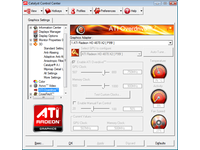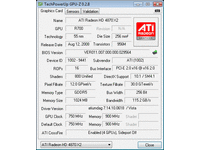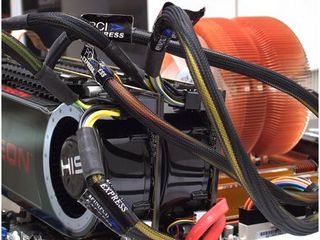Radeon HD 4870 X2: Four Cards Compared
Radeon HD 4870 X2 Crossfire (4CF)

If you have the cash for it and have a compatible motherboard, plus >800 watt power supply, you can combine two Radeon HD 4870 X2 cards using CrossFire. Once you’ve connected the bridge and activated the CrossFire mode in AMD’s driver, you’ll have four RV770 graphics chips running cooperatively (4CF). With the overclocked quad-core CPU, the test system demands 775 watts from the socket under full load. The power supply has to provide 660 watts with 55 amps (12 V). In 2D mode, the demand is still 295 W (at the plug). This is only 15 watts more than a CrossFire combination of two HD 4870s, which can’t currently throttle clock speeds.

We did not overclock the video cards for our four-way tests because the quad-core CPU with its 3.67 GHz frequency can barely handle one dual-chip card. With two X2 boards, the CPU limits performance potential even more, and the test system can’t really take advantage of the additional graphics power. When looking at the overall test result, the additional 5% in performance from the fastest 4-chip combination is somewhat disappointing.
The HD 4870 X2 CrossFire (4CF) really shows its worth in games based on the UT3 engine (such as Mass Effect), with high resolutions, maximum anti-aliasing, and anisotropic filtering. In this situation, with the support of an overclocked CPU, you can gain an additional 76% in frame rate. We’ll show you a detailed comparison between X2 and X2 CrossFire (4CF) after the benchmarks.

For our combination, we used the test cards from HIS and Sapphire—both of the reference-clocked boards. After starting up Vista, the CrossFire combination gets stuck in the same 2D driver error, which doesn’t allow the cards to fully reduce their clock rate. As long as you don’t start a 3D application, the power consumption of the test system remains at 330 watts (at the socket). Once the driver has to change the clock speeds, it drops the 2D power consumption down to 295 watts.
The behavior of the HIS card is interesting. In 3D mode, the graphics chips (GPUs) can easily take 91 to 92 degrees in CrossFire mode. In single-card operation, we saw image errors if the HIS GPUs did not get enough time to cool down. When you look at the GPU load during the tests, it is always at 100% in both single-card and CrossFire mode, and the fan speed ranges between 3,200 and 3,900 RPM.

If you don’t have an angled plug, the wiring for the power supply is somewhat cumbersome. Because the ports sit on the side but the connectors point downward, the second card is in the way. Either the cables bend the board or you have to pinch the cables, neither of which is ideal for long-term use. We saw the same problem with the Radeon HD 3870 X2 CrossFire, which Nvidia solves by having the connectors point sideways, facing toward you as you look down on the installed card.

Stay on the Cutting Edge
Join the experts who read Tom's Hardware for the inside track on enthusiast PC tech news — and have for over 25 years. We'll send breaking news and in-depth reviews of CPUs, GPUs, AI, maker hardware and more straight to your inbox.
Current page: Radeon HD 4870 X2 Crossfire (4CF)
Prev Page Software Sapphire Radeon HD 4870 X2 Next Page Assassin’s Creed v1.02-
Not only do we have four super-fast Radeon HD 4870 X2s to test, but also a list of 31 other graphics configurations including CrossFire and SLI setups. If you're in the market for AMD's fastest card available, you'll want to see this.Reply
Radeon HD 4870 X2: Four Cards Compared : Read more -
neiroatopelcc "Because of accessories and price, Sapphire is our best-buy recommendation."Reply
One slight warning about sapphire though. If you have problems, don't expect their support team to help you before you've solved the problem yourself!
I made a ticket regarding some issues with my 4870 on august 7th, and received a reply on the 26th of september! That's 46 days to address an error they simply stated would go away with a bios upgrade from their homepage!
As for the article, I actually liked the detailed driver errors they encountered. Not that I liked the errors themselves, but I liked them being explained. Usually you just read 'after spending some hours resolving driver errors ....' without getting any wiser. -
Pei-chen Wow, AMD cards consume power like a Detroit SUV. I like Nvidia GTX 2xx series’ Toyota Prius like efficiency at idle.Reply -
ilovebarny Why didnt they use the GTX260 Core 216? its like way better than the regular GTX260. And i just read yesterday that Nvidia was only going to make GTX260 Core 216 now. http://www.fudzilla.com/index.php?option=com_content&task=view&id=10497&Itemid=1Reply -
enforcer22 Pei-chenWow, AMD cards consume power like a Detroit SUV. I like Nvidia GTX 2xx series’ Toyota Prius like efficiency at idle.Reply
Hmm your right. Power house vs crippled mouse.. yeah your analagy sucked im sure mine did to but all i saw from what you typed was i like weak stuff dont give me more power. -
bdollar seems to me if you are going to be comparing the highest end cards and even crossfire them for 4x you would have the highest resolution as one of the options. i would think people considering going x2 in crossfire would consider a 30" screen.Reply
don't get me wrong, i liked the article but would have liked to have seen the resolution spectrum hit the top. -
It's nice to see the 9800GX2 included in the tests. I was considering the 4870x2 due to all the rave reviews but they never had the comparison like this against my current 9800GX2. I won't be getting new card anytime soon it seems. Thanks.Reply
Most Popular

